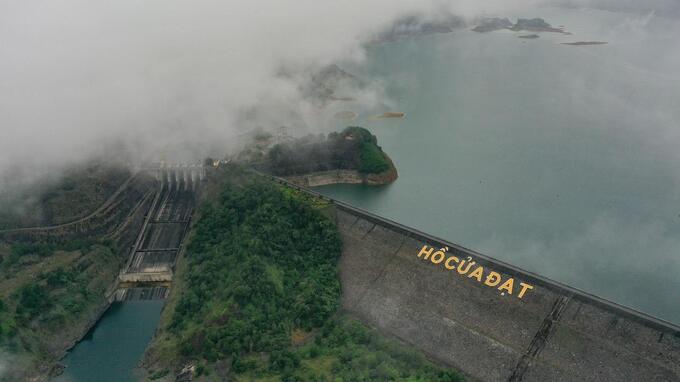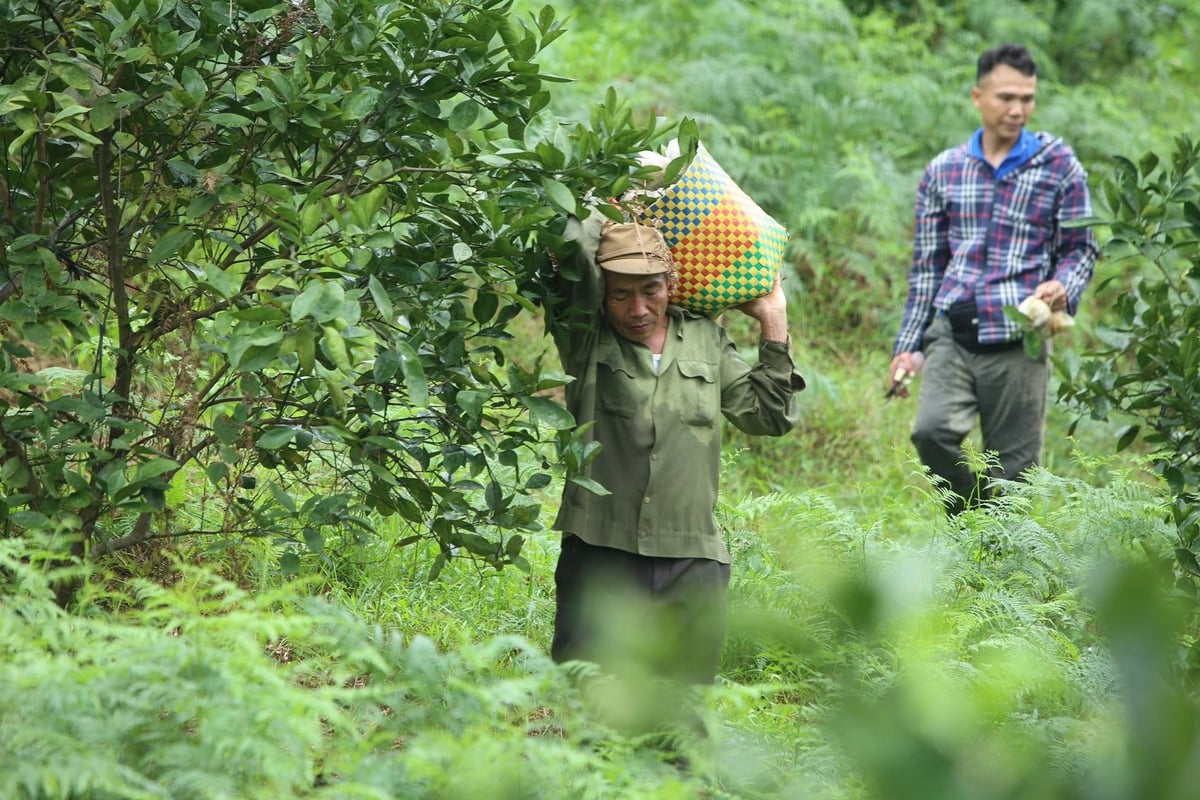December 7, 2025 | 19:14 GMT +7
December 7, 2025 | 19:14 GMT +7
Hotline: 0913.378.918
December 7, 2025 | 19:14 GMT +7
Hotline: 0913.378.918
The North Central region of Vietnam is often known as a land scorched by hot Lao winds, plagued by severe floods in the rainy season and parched fields during the dry season. However, from the perspective of Professor Dr. Tran Dinh Hoa, Director of the Vietnam Academy for Water Resources, behind this harsh image lies a hidden potential – a vast reserve of water resources that presents a unique advantage for economic development.
According to statistics, Vietnam currently has over 6,700 irrigation reservoirs with a total capacity of around 14.5 billion cubic meters. Among them, Thanh Hoa alone has 610 reservoirs holding more than 2.2 billion cubic meters of water, including the Cua Dat reservoir, which contains over 1.4 billion cubic meters. Nghe An has over 1,000 reservoirs with a total volume of more than 500 million cubic meters, notably the Vuc Mau reservoir with over 74 million cubic meters. Ha Tinh boasts more than 320 reservoirs holding over 1.5 billion cubic meters, including the Ngan Truoi reservoir with over 770 million cubic meters. Quang Binh adds another 150 reservoirs with a combined volume of more than 460 million cubic meters of freshwater.

The Cua Dat Reservoir is one of the key irrigation projects in northern Vietnam. Photo: Tung Dinh.
“Focusing on the three key provinces of Thanh Hoa, Nghe An, and Ha Tinh, the number and capacity of reservoirs are remarkably high, with nearly 2,000 reservoirs, accounting for almost 30% of the country’s total, and a combined capacity of 4.4 billion cubic meters, or roughly 30% of the national water storage,” noted Professor Dr. Tran Dinh Hoa. “The distribution of water resources, especially the density of reservoirs in these areas, plays a crucial role in crop restructuring and agricultural development.”
This advantage should be viewed from two angles. First, the total water storage capacity is a major and vital asset that ensures stable crop development. Second, the large number of irrigation reservoirs not only helps mitigate flooding but also allows water to be distributed more widely across the region. This facilitates investment in water supply systems for farming areas, ultimately helping to reduce infrastructure costs.
Expanding on the water supply requirements and sustainable development of crops like pineapple, tea, and citrus trees, Professor Dr. Tran Dinh Hoa explained that these crops require significantly less water than rice and mainly need irrigation during the dry season. Their water demand is only about 35–50% of that of rice, depending on the number of cropping seasons per year. This aligns well with the water supply potential and existing infrastructure in the North Central provinces.
“When considering the potential for cultivating and commercializing any crop, we usually assess three factors: soil quality, climate conditions, and resistance to pests and diseases,” Prof. Hoa noted. “In practice, the North Central region, particularly the provinces of Thanh Hoa, Nghe An, and Ha Tinh, proves to be highly suitable for citrus crops.” He pointed to examples such as the sweet Vinh oranges of Nghe An, Huong Son cam bu, the renowned Phuc Trach pomelo of Ha Tinh, the golden-fragrant pineapples of Ha Trung in Thanh Hoa, and the iconic green tea of Nghe An, all of which have become well-established brands in both domestic and international markets.
According to Mr. Nguyen Duc Cuong, Deputy Director of the Thanh Hoa Department of Agriculture and Environment, the province has significant potential for developing tea, pineapple, and citrus fruit cultivation. With 4,000 hectares of pineapple, Thanh Hoa produces around 60,000 to 70,000 tons annually.
“With the introduction of promising new varieties, productivity is expected to continue rising. As for citrus, the province currently has about 4,800 hectares under cultivation, focusing mainly on oranges and pomelos,” Mr. Cuong said. “Notably, seedless lychee production is a new initiative in Thanh Hoa, and this year, it has begun to make its way into the Japanese market.”

The North Central region, particularly the three provinces of Thanh Hoa, Nghe An, and Ha Tinh, is highly suitable for citrus fruit cultivation. Photo: Thanh Nga.
However, according to the Department of Agriculture and Environment of Thanh Hoa province, the production, processing, and consumption of agricultural products in the province still face several limitations. Investment by businesses and cooperatives in pineapple, tea, and fruit crops remains fragmented and small-scale. In response to these challenges, the province issued Resolution 185/2021/NQ-HDND, partly aimed at supporting the development of fruit trees and other key crops.
From 2026 to 2030, the Department of Agriculture and Environment plans to propose that the provincial People’s Committee adopt specialized mechanisms and policies for the entire agriculture–environment sector in Thanh Hoa. To achieve deep and sustainable integration into export markets, it is essential to tightly link production chains with science and technology, advanced processing, and brand building.
“The province will expand its planning for fruit-growing areas while actively promoting trade, attracting investment, and developing both domestic and international markets,” Mr. Cuong emphasized. “Such efforts cannot succeed without the support of central ministries and local authorities, especially in shaping a sustainable crop development strategy that helps improve farmers' incomes.”
In line with this, the Department of Agriculture and Environment of Thanh Hoa is currently implementing a soil mapping initiative, aiming to complete land assessments in 66 communes by 2025, and cover the remaining 100 communes by 2026. The goal is to identify suitable crops for each area and improve overall production efficiency.
Translated by Phuong Linh

(VAN) After three years, Project FST/2020/123 collected approximately 3,000 insect specimens, classified them into about 50 morphological groups, and identified around 40 species, including several new species.
/2025/12/01/0509-2-175427_206.jpg)
(VAN) Emission-reducing coffee areas in Lam Dong have entered the new crop with stable yields, improved quality, and a remarkably enhanced cultivation environment.

(VAN) The Institute of Agricultural Sciences for Southern Vietnam (IAS) marked its 100th anniversary in Ho Chi Minh City, celebrating a century of growth as a leading institute contributing significantly to Viet Nam’s agricultural development.

(VAN) An increasing number of livestock farms are using biogas generators to create a source of renewable electricity, helping to save costs and mitigate environmental pollution.

(VAN) Small changes in rice cultivation, from irrigation methods and straw collection to input management, are paving a new way for Vietnam's agriculture in the journey toward emission reduction.

(VAN) With the project of converting biogas into renewable electricity, Australia is both helping pig farms reduce their energy costs by up to 25% and contributing to environmental protection.
![Hue aims for Net Zero: [1] Initial steps from green transportation](https://t.ex-cdn.com/nongnghiepmoitruong.vn/608w/files/huytd/2025/11/28/0853-anh-6-giao-thong-xanh-hue-094717_940-153724.jpg)
(VAN) For sustainable development, Hue City is implementing many solutions to promote green transportation, which is an important initial step on the journey to building a Net Zero Hue.